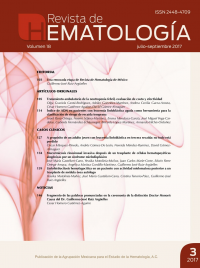Rev Hematol Mex. 2017 jul;18(3):105-113.
Cantú-Rodríguez OG, González-Martínez A, Garza-Acosta AC, Gutiérrez-Aguirre CH, Gómez-Almaguer D
Servicio de Hematología, Universidad Autónoma de Nuevo León, Hospital Universitario Dr. José Eleuterio González, Monterrey, Nuevo León, México.
Resumen
ANTECEDENTES: la neutropenia febril es una complicación común de la quimioterapia que repercute significativamente en la respuesta al tratamiento y es de manejo costoso. El tratamiento ambulatorio es una alternativa para los pacientes en riesgo bajo, con el soporte de una clínica que facilite el acceso temprano a laboratorio y medicamentos. Un beneficio adicional de esta opción es mayor capacidad de atención de pacientes optimizando recursos económicos por abatimiento de costos. En la actualidad existen estudios comparativos de tratamiento intrahospitalario y ambulatorio, así como análisis de costos que esto genera, pero no hay reportes en México.
OBJETIVO: evaluar los resultados del tratamiento de la neutropenia febril en pacientes con enfermedades hematológicas en el entorno intrahospitalario y en el ambulatorio, además de la seguridad, eficacia y conveniencia de esta última alternativa y los costos de atención de estos pacientes en nuestro centro.
MATERIAL Y MÉTODO: estudio descriptivo, prospectivo y observacional, realizado de agosto de 2014 a junio de 2015. Se incluyeron pacientes con enfermedad hematológica que padecieron neutropenia febril. Los pacientes en riesgo bajo según la escala de MASCC recibieron tratamiento ambulatorio en la clínica del servicio de Hematología.
RESULTADOS: se incluyeron 39 pacientes, de los que 62% recibió tratamiento intrahospitalario y 38% ambulatorio. No encontramos diferencias significativas en los días de tratamiento, tiempo de recuperación de la neutropenia ni en cambios de tratamiento antibiótico. La media del costo ambulatorio fue de 10,796.22 pesos y del tratamiento hospitalario fue de 41,160.34 pesos (p = 0.001). En el grupo ambulatorio 4 pacientes requirieron internamiento en días posteriores. Hubo 5 defunciones, 3 en el grupo de tratamiento intrahospitalario y 2 del grupo ambulatorio que posteriormente fueron hospitalizados (p = 0.649).
CONCLUSIONES: el tratamiento ambulatorio de la neutropenia febril en pacientes con enfermedad hematológica de bajo riesgo puede tener buenos resultados y es significativamente menos costoso que el tratamiento hospitalario.
PALABRAS CLAVE: neutropenia febril, tratamiento ambulatorio, tratamiento intrahospitalario, costo.
Ambulatory treatment of febrile neutropenia, cost and effectiveness assessment.
Rev Hematol Mex. 2017 July;18(3):105-113.
Cantú-Rodríguez OG, González-Martínez A, Garza-Acosta AC, Gutiérrez-Aguirre CH, Gómez-Almaguer D
Servicio de Hematología, Universidad Autónoma de Nuevo León, Hospital Universitario Dr. José Eleuterio González, Monterrey, Nuevo León, México.
ABSTRACT
BACKGROUND: Febrile neutropenia is a common complication of chemotherapy that significantly impacts on treatment response and requires an expensive management. Outpatient treatment is an alternative for low risk patients, supported by a clinic that facilitates early access to laboratory and medication. An additional benefit is a greater capacity of patient care, optimizing economic resources by cost reduction. There are currently comparative studies with hospital admission and outpatient management, as well as cost analysis; never-theless, there are no reports in Mexico.
OBJECTIVE: To assess the results of treatment of febrile neutropenia in patients with hematological diseases in the intrahospitalary and ambulatory setting, besides the safety, efficacy and convenience of the latest and costs of care of these patients in our center.
MATERIAL AND METHOD: An observational, descriptive, prospective study was performed from August 2014 to June 2015, involving patients with hematological disease and febrile neutropenia. Patients at low risk according to the MASCC scale received outpatient management at hematology clinic.
RESULTS: There were included 39 patients, from which 62% received hospital admission, and 38% outpatient management. We found no statistically significant differences between the two groups regarding treatment days, neutropenia recovery time, or changes in antibiotic treatment. The average outpatient cost was 10,796.22 Mexican pesos and that of the hospital management was 41,160.34 Mexican pesos (p = 0.001). In the outpatient group, 4 patients required hospitalization on subsequent days. There were 5 deaths, 3 in the inpatient treatment group and 2 in the outpatient group subsequently hospitalized (p = 0.649).
CONCLUSIONS: Outpatient management of febrile neutropenia in low-risk patients may be successful and significantly less expensive than hospital management.
KEYWORDS: febrile neutropenia; outpatient treatment; hospital admission; cost

